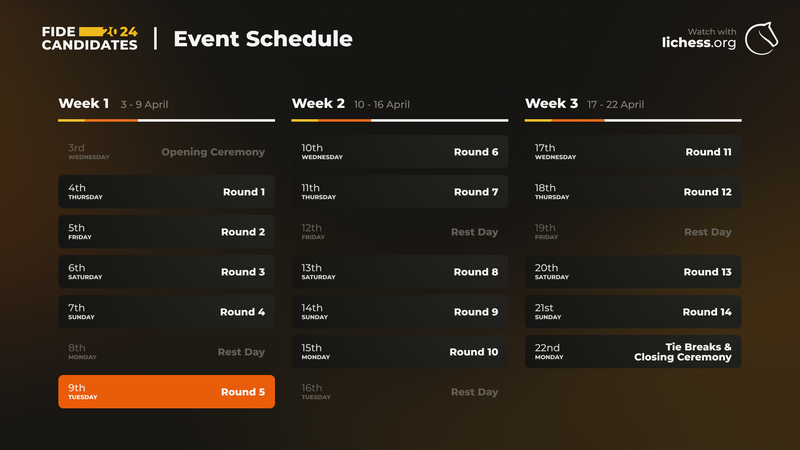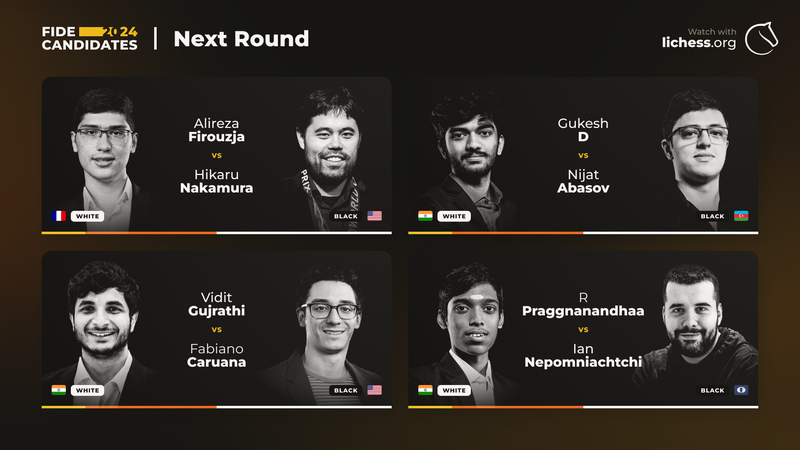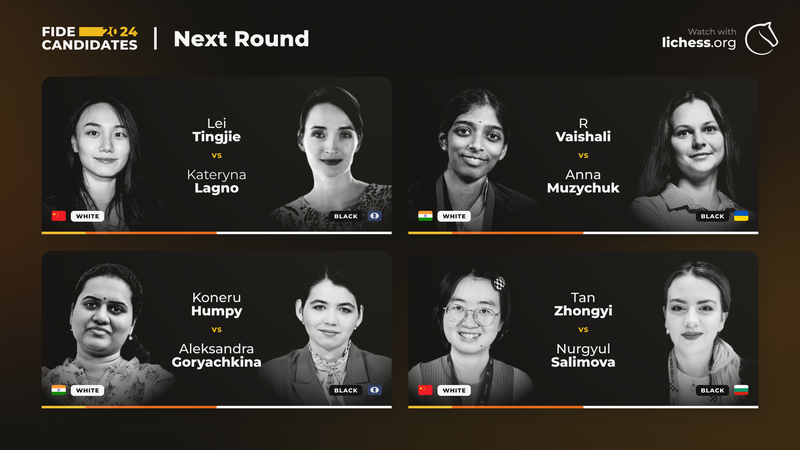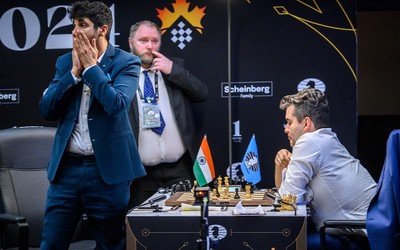
FIDE / Maria Emelianova
Candidates Round 4: Nepomniachtchi in Sole Lead While Tan Retains Her Lead
Nepomniachtchi wins in the Open section with the Berlin, while a rollercoaster day in the Women's Section ends with Salimova as the sole winnerCalm after the storm, storm after the calm ... That seems to be this year's Candidates tournament spirit so far. Yesterday's round was a rather peaceful one, only with Praggnanandhaa's and Vaishali's wins standing as outliers. Today, it was the exact opposite situation — the siblings drew their respective games in rather uneventful fashion, while most of the other boards were ablaze. Nepomniachtchi's win sends him into the rest day as the sole leader of Open Section, while Women's section was an emotional rollercoaster, out of which Salimova scored her first win.
With all of that, we return to tranquility with tomorrow's rest day.
As well as broadcasting the live games from the two tournaments, Lichess is providing a live stream for every day of the Candidates. Make sure to tune in to our Twitch or YouTube channels, with streams starting from 14:15 Toronto time (18:15 UTC).
We're also providing daily annotations on some of the games from GM Brandon Jacobson and IM / WGM Padmini Rout.
Schedule

Round Recap
Open Section
A queen endgame a pawn up and a Berlin endgame — which of those two are more likely to be drawn? If you answered they both lead to draws, you'd be right, but not today. Famed for its drawish reputation more so than anything else, the Berlin endgame netted the White player, Nepomniachtchi, a victory today. Firouzja and Caruana were unable to win their pawn-up queen endgames, and actually had no chances to press for an advantage. Nakamura and Praggnanandhaa drew a relatively insipid game.
There's a reason why Maxime Vachier-Lagrave is so insistent on going for the Berlin endgame as White — he figures that he'll never lose, and, sometimes, might actually win because the Berlin endgame isn't as drawish as people believe it is. Nepomniachtchi took a page out of Vachier-Lagrave's book and went for the rare 11. g4, which has never been tried at the top level, and perhaps for good reason. With the even more unconventional followup, 12. Nh2, Nepomniachtchi bamboozled Vidit and slowly kept improving his position. Vidit seemed to have matters under control, however, but he gave Nepomniachtchi good practical chances with a passed e-pawn, which eventually found its way to the 7th rank and, soon, the promised promotion land. GM Brandon Jacobson explores the hidden depths of the Berlin endgame:
Caruana showed once again that he's in good form as he pressed a meager advantage against Gukesh. Caruana was unable to extract any water from Gukesh's stone, though, and the pawn-up queen endgame that ensued was the furthest from winning as Caruana's extra pawn was doubled and on the kingside, where all the other pawns were. Caruana kept trying, but eventually agreed to a draw on move 74. GM Brandon Jacobson shows us how to play like Caruana:
Firouzja has clearly come in with some fresh ideas as he played some rare moves in the Nimzo-Indian, starting with 4...d6. Abasov went for a very solid, typical, and logical setup, though, and got out of the opening with no disadvantage whatsoever — but no advantage as White, either. He then found a way to liquidate, going for a pawn-down queen endgame which was similar to that of Caruana and Gukesh in that the side with the extra pawn could never realistically hope to win. Firouzja did try for a while, though, but eventually signed the scoresheets on the 64th move.
Praggnanandhaa essayed the popular Rb8 idea in the Ruy Lopez, and it seemed as if Nakamura did not have anything special prepared against said idea as Praggnanandhaa played the relatively rare 7...h6. An early repetition was eventually forced, ending the game in a draw on move 24.
Following these results, our simulations show that Nepomniachtchi and Caruana are still the favorites to win the event, but Gukesh also has decent chances to secure the victory. The remainder of the field have outside chances to come back and win it all.
| Player | Win probability | Most frequent predicted position | Predicted points average |
|---|---|---|---|
| Ian Nepomniachtchi | 40.1% (+17.2%) | 1 (+1) | 8.5 (+0.5) |
| Fabiano Caruana | 33.6% (-11.9%) | 1 (=) | 8.4 (-0.2) |
| Gukesh D | 14.9% (+0.8%) | 3 (=) | 7.8 (+0.2) |
| R Praggnanandhaa | 5.5% (-0.2%) | 4 (+1) | 7.0 (+0.1) |
| Hikaru Nakamura | 2.6% (-1.5%) | 6 (=) | 6.7 (-0.1) |
| Alireza Firouzja | 2.0% (-1.3%) | 6 (+1) | 6.6 (=) |
| Vidit Gujrathi | 1.0 (-3.1%) | 7 (-1) | 6.2 (-0.7) |
| Nijat Abasov | 0.1% (=) | 8 (=) | 4.9 (+0.2) |
Women's Section
Complications. Excitement. Upsets. Missed opportunities. This is how one could describe today's round. After the game between Goryachkina and Vaishali ended in a mostly uneventful draw, two exciting, complicated middlegames were left — with Anna Muzychuk, who was masterfully creating an advantage out of seeming equality in her game against Lei, adding to the excitement. Indeed, at some point, it appeared that three wins with the White pieces would be likely. The game isn't over until the clocks have stopped and the scoresheets have been signed, though, and the three defending players had definitely not said their last word yet. Out of all of this mayhem, Salimova emerged as the sole victor.
Let's start with today's outlier. For round 4, Goryachkina faced Vaishali. The game started with the versatile 1.Nf3, later transposing into an English-esque position and finally into a Tarrasch proper. Out of the opening, Black was saddled with an isolated queen's pawn; in this specific case, however, it never really became either a strength or a weakness. With the two players being faithful to their plans, they did not give each other any serious opportunity to gain an edge. By move 30, all the minor pieces were exchanged, and the game concluded in a draw on move 40, with the two players still having never scored a win against each other in an official classical game.
The game between Lagno and Tan was definitely expected to be exciting, and it certainly did not disappoint. With a Najdorf Sicilian on the board, the game entered into relatively uncharted territory quite early on, with 11.a4 b6!? — seemingly when Lagno's preparation must have ended, based on her time usage. What seemed to be until move 28 an equal, but complicated, middlegame, was soon going to change. Tan's 28...Qa2 and her attempt to infiltrate her opponent's position didn't work in her favour - in fact it gave Lagno the neccessary tempos to improve her pieces' positions, make use of her passed d-pawn, later even creating a second passed pawn. For most part of the game, she seemed to have the position under control and seemed to be headed toward a win. Her opponent, however, had definitely not given up.
On move 49, Lagno played the move 49.Qf3; a queen exchange would definitely make sense, though it was by no means forced. Thus, 49. Qf3 essentially just inactivated Lagno's centralized queen. While this wasn't decisive on its own, this change in the character of the position indirectly allowed Tan's comeback combination later on. With the rooks exchanged after 50. Ra8 Rxa8 51. Qxa8, Tan played the tricky 51...h4. Had Lagno replied with 52. Bf2, she could still have been able to convert. Unfortunately for her, 52. Be5 allowed 52...Qe6!, which gave her the option to either retreat and drop the pawn or be forced to enter a drawn queen endgame due to perpetual check. The latter occurred, and Tan managed to save the half point. IM / WGM Padmini Rout explains how the tournament leader narrowly escaped a loss:
Salimova is not new to chaotic, complex, or sharp positions in this Candidates tournament, but this time, she was on the winning side of the complications. Humpy showed that she wanted to fight for a win, playing a Stonewall Dutch setup against Salimova's Catalan. With an h-pawn push on the 9th move of the game, Humpy was out for a kingside attack early on, so Salimova had to take measures to prevent the incoming kingside onslaught. Those measures worked, and Salimova soon stabilized and had an advantage due to her well-coordinated pieces. After Humpy connected her rooks by posting the king on the f7 square, Salimova followed suit and evacuated the kingside by playing 22. Kf2, a very brave and correct decision. It turned out that her king was much better placed than would be expected, and after what looked like a necessary queen trade, Salimova found herself in a winning endgame, which she duly converted. IM / WGM Padmini Rout walks you through the mind-boggling complications:
Muzychuk, coming off a missed opportunity in round 3, which was absolutely not easy to find in a real game, played the exchange French against Lei. Her intentions to push for a win were visible early on as she went for a position with an isolated queen's pawn, one of the ways to create imbalances in the Exchange French. However, this was not your everyday IQP exchange French — Bg5 and Nbd2 had already been played, which are an uncommon, not so thematic approach in this position. Not only that, but Muzychuk also early on committed to an h3-g4 kingside pawn push, which is a very double-edged decision. With the h3-g4 pawn structure, Lei had the option to go for a Kg7 - Rh8 plan with a kingside attack, but this did not take place in the game. Muzychuk eventually picked up a pawn, but Lei was banking on having enough activity to offset her pawn deficit. That was indeed the case for a while, but Muzychuk found some nice ideas in the resulting double rook endgame and was all but winning after Lei sacrificed her rook for Muzychuk's passed e-pawn. Just as that had transpired, though, Muzychuk blundered on the next move, missing a chance to outflank her opponent's king with her own. Tragically for Muzychuk, she drew her second winning game in a row on the 75th move.
Following these results, our simulations show that Tan remains the favorite to win the event, but Goryachkina is still in it with a good shot. Lagno also has reasonable chances to win, while the remainder of the field have outside chances to get the coveted challenger spot.
| Player | Win probability | Most frequent predicted position | Predicted points average |
|---|---|---|---|
| Tan Zhongyi | 47.1% (+7.9%) | 1 (=) | 8.6 (=) |
| Aleksandra Goryachkina | 27.6% (-3.3%) | 1 (=) | 8.1 (-0.3) |
| Kateryna Lagno | 11.8% (-0.1%) | 3 (=) | 7.5 (-0.1) |
| Humpy Koneru | 4.2% (-7.4%) | 5 (-2) | 6.7 (-0.8) |
| Lei Tingjie | 3.3% (+0.6%) | 6 (=) | 6.6 (=) |
| R Vaishali | 3% (+1.2%) | 6 (+1) | 6.5 (+0.3) |
| Anna Muzychuk | 1.8% (+0.2%) | 8 (-1) | 6.2 (=) |
| Nurgyul Salimova | 1.1% (+0.9%) | 8 (=) | 5.8 (+0.9) |
Round 5 Preview
In the Open, Firouzja will face a player he's very familiar with in Nakamura. Gukesh takes on Abasov and will be looking to get into the lead with a victory over the ever solid Abasov. Vidit, who looked to be storming through after his round 2 victory over Nakamura, has lost his last two games and will have to face an in-form Caruana. The tournament's leader, Nepomniachtchi, will have to defend as Black against a surging Praggnanandhaa.

In the Women’s section, the tournament leader, Tan, will play against Salimova, who's coming off her first win. Lei, showing enterprising play, will take on Lagno, while Muzychuk, who has missed two winning opportunities in rounds 3 and 4, will probably look to stabilize against Vaishali, who showed some very powerful preparation as White in round 3. Humpy, who showed fighting spirit in round 4, will have to contend with a very solid Goryachkina, who so far has shown no crack in her armor.

Make sure to follow the action with us in Round 5!
More blog posts by Lichess

Round 14: Gukesh and Zhongyi are officially the World Championship Challengers
A historic finish to the FIDE Candidates, as 17 year old Indian prodigy becomes the youngest World C…
Candidates Round 13: Gukesh takes the lead, Zhongyi pulls ahead
A massive day for the 17 year old Indian, as his chances to win the Candidates skyrockets, as Zhongy…
Candidates Round 12: Three-ways Tie in Open, Tan Maintains her Lead
Nakamura and Gukesh catch up with Nepomniachtchi in Open, while Tan maintains a safe distance from e…
